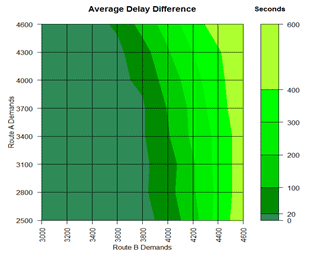U.S. Department of Transportation
Federal Highway Administration
1200 New Jersey Avenue, SE
Washington, DC 20590
202-366-4000
Federal Highway Administration Research and Technology
Coordinating, Developing, and Delivering Highway Transportation Innovations
| ARTICLE |
|
For FHWA’s Exploratory Advanced Research (EAR) Program, a National Research Council (NRC) Research Associate, Dr. Ximiao Jiang, is pursuing research on traffic performance analysis of dynamic merge control (DMC) using micro-simulation modeling. DMC can be used in freeway merge areas to dynamically change lane allocation at interchanges. If traffic is not heavy on one of the freeways, the DMC closes a lane to reduce disturbances in the merge area with another freeway or an on-ramp.

Figure: After implementing DMC, the average delay per vehicle
was reduced by up to 540 seconds (around 98%). The average
vehicle delay accounts for the waiting delay of vehicles that were
not able to access into the network on their scheduled time.
Dr. Jiang used VISSIM micro-simulation to investigate DMC strategies. One of the strategies was to investigate DMC efficiency where three-lane and two-lane freeways merge into four lanes, and explore optimum thresholds for activating and deactivating DMC. The research is co-sponsored by FHWA’s Office of Operations R&D where Dr. Joe Bared is the NRC advisor for the project.
Research results indicated that the proposed DMC strategy is very beneficial for the hypothetical network under certain traffic volume situations. Specifically, the DMC strategy could reduce the average vehicle delay by up to 98 percent and it could increase the average vehicle speed by up to 90 percent. Additionally, it was concluded that the capacity of the merge area was noticeably increased under the DMC conditions. A brief of this research is available on page 9 of the autumn-winter 2014 issue of NRC s The Postdoc newsletter: http://sites.nationalacademies.org/cs/groups/pgasite/documents/webpage/pga_153210.pdf . A full article was accepted for publication in a 2015 edition of the Transportation Research Record: Journal of the Transportation Research Board.